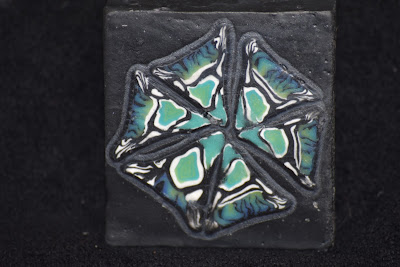Caning and Using Soap Dough like Polymer Clay
I have been wondering about the use of soap in the same way that polymer clay is used to create effects. I tried once before but used "hot" soap, which is not saponified at all. I used tapioca starch to prevent sticking but it required quite a lot while I was working and overall, it was not worth the effort.
I tried again recently using saponified soap dough. Having never worked with polymer clay, I watch a lot of videos of people working with it, trying to imagine the same with soap dough. Having just started down this path, I am finding that, so far, many of the same issues and rules apply. The same basic canes can be built and used together to form interesting patterns and beautiful things. I do not own a pasta machine but working with the dough I have, I am not confident that sheets of soap dough could be processed 30 times over and over to make a Skinner roll without making a mess of the machine; my dough was sticky enough with repeated rolling that a lot of corn starch or tapioca starch or some powder would need to be used to prevent sticking and that much would affect the finished product. I rolled my soap dough out between sheets of plastic wrap, which worked well and allowed for a lot of manipulation without having to dust it. It is possible to make a Skinner roll by hand. It's possible that sending it through a pasta machine between plastic sheets would work, although I can see the possibility of the sheets tearing and making a gunky mess.
It is a pretty labor intensive project, which I assume the case to be with polymer clay as well. I learned the hard way about all the pieces being of the same temperature and softness. I had made a large flower cane and then made the leaves to surround it but did not wait for long enough for the leaves, which had just been worked, to cool and stiffen to match the flower. Holy hell, did I end up with a mess when trying to reduce it. The leaves squished splendidly but the most inside part of the flower refused to move at all, which results in an oddball flower. I got kind of pissed and forced half of my very short and wide cane (about 2.5-3 inches across) to reduce down to about an inch and changed the shape from round to square but there is nothing left of the original image in there. It's now abstract art. The other half remained in its oddball shape and got imbedded.
I don't know how big a cane one can start with and successfully reduce, or how much one can reduce and still see the image intended. I have a feeling that soap will not act entirely like polymer clay but time will tell. I have found that soap with opaque colorants, like TD, give the best and sharpest lines and clear colorants give the least. Some of the micas didn't bring the level of distinction I was expecting, even when I heavily colored the batter, but figuring this out is part of the fun. I was able to take a simple roll that was 1-2 inches long and reduce it by pressure and rolling to nearly a foot long. I took the cane I made for the kaleidoscopes from 1-2 inches to 6 inches with fair success but so far I felt like I got the best results from a doubling, and not more, by going from 3 inches to 6 inches and then cutting.
It doesn't require much to start. I used mainly a roller and plastic wrap, although I did splurge to get some high tech equipment- a Play-doh Fun Factory- to be able to extrude some shapes. It's a pain to clean out though so I didn't use it as much as I intended, although there is a lot of potential there as well.
The bars look better in real life. Really.











Very good technique and I love your work. The colors and placement are beautiful!
ReplyDeletewow look so originative. I like your creation
ReplyDeleteword cookies answersaz
archery games
scratch games
Thank you! Lots of potential, I think, in soap dough. Thank you for commenting!
ReplyDelete